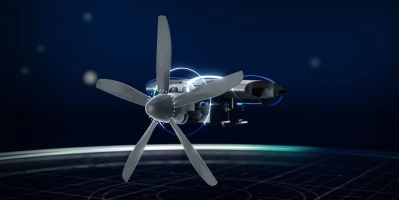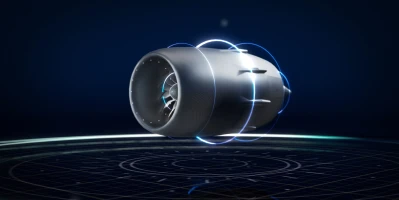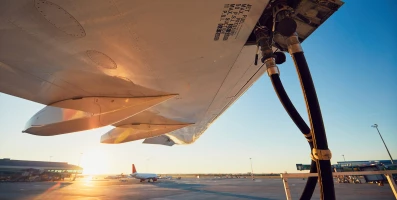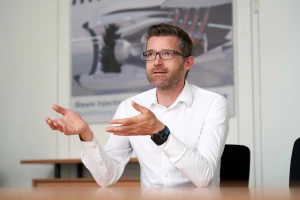innovation
New production processes reduce aviation's environmental footprint
Green production goes hand in hand with clean aircraft, which is why environmentally friendly manufacturing processes are becoming increasingly important.
03.2018 | author: Monika Weiner | 4 mins reading time
author:
Monika Weiner
has been working as a science journalist since 1985. A geology graduate, she is especially interested in new developments in research and technology, and in their impact on society.

The lighter and quieter the better: in the interest of protecting the environment and cutting operating costs, aircraft and engine manufacturers are busy fine-tuning their products to trim every last gram of weight and decibel of noise.
Thanks to new technologies, today's aircraft consume 45 percent less fuel than those in service in the 1960s. Over the next few decades, innovative designs and propulsion concepts are set to halve CO2 emissions and fuel burn again. This will preserve the earth's oil resources, protect the environment and help airlines cut down their fuel costs. But it's not just a case of protecting the environment when aircraft take to the skies. "Clean production and efficient manufacturing and maintenance processes all contribute to making an aircraft 'clean'," says Stefan Lange who heads up building and plant modernization at MTU Aero Engines.
„Clean production and efficient manufacturing and maintenance processes all contribute to making an aircraft ‘clean’.“
Reducing emissions and consumption despite increasing production volumes
With the objective of improving energy efficiency and conserving resources, airframers and engine manufacturers are methodically analyzing and optimizing their production processes. At its European sites, Airbus, for instance, has reduced its energy consumption by three percent, CO2 emissions by 14 percent and volatile organic compound emissions by 21 percent within ten years. At the same time, the airframer succeeded in cutting water usage by 19 percent, despite increasing the number of aircraft produced in the same period by one third. In 2006, Airbus introduced a treatment system for river water at its Hamburg site in Germany, which cut annual drinking water consumption by 82,000 cubic meters. A special sensor system for the early detection of leaks resulted in further savings of 10,200 cubic meters.
MTU, meanwhile, launched a program to reduce its environmental footprint in production and maintenance back in 2010. Thanks to CLAIR-IS, an acronym for Clean Air Industrial Site, Germany's leading engine manufacturer has achieved savings in CO2 emissions to the tune of 20,000 metric tons at its Munich site alone since it began upping the use of well water for cooling machinery. In November 2017, MTU introduced a new cogeneration plant that runs on bio-methane, reducing CO2 emissions by a further 6,800 metric tons a year. To make additional energy savings, the company insulates its buildings, repairs leaks in compressed air systems and switches off machines and equipment at night and on public holidays. And production isn't the only area in which MTU is going green. MTU Maintenance Canada based in Richmond, British Columbia, has joined an initiative led by nearby Vancouver International Airport to measure and analyze its carbon footprint. MTU's Canadian subsidiary is now using this information to systematically reduce its emissions. The facility now runs exclusively on hydropower, a renewable source of energy. "In the last 25 years, we've halved our overall CO2 emissions here at MTU," says Lange to sum up.


High-tech manufacturing process in use at MTU: Additive manufacturing
Additive manufacturing: MTU is one of the first companies in the aero engine industry to 3D print production parts. To the video
Processes that conserve resources
Today, MTU's engineers employ innovative technologies such as additive manufacturing to produce components for tomorrow's clean engines with maximum efficiency and using as little energy as possible. "This way, we can generate parts straight from CAD data. A laser melts the metal powder particle by particle and builds it up layer by layer precisely as specified," says Dr. Karl-Heinz Dusel, who heads additive manufacturing technology at MTU. He goes on to explain that this production method has several benefits: "No material goes to waste. At the end of the process, any loose metal power is shaken off, filtered and recycled. Plus, you need less material allowance compared with traditional methods, such casting or machining forged components, because the blank requires only minimal rework." Another advantage is that this technique allows new functions to be integrated directly into the component-cooling holes, for example. Optimized design also reduces weight. The design engineers plan to ramp up use of the technology in the future. MTU already uses additive manufacturing for the large-scale production of borescope bosses for PW1100G-JM engines. The next step is to apply for approval to manufacture lightweight brackets that support oil lines in the same way.
"New, resource-conserving processes like additive manufacturing are extremely important for reducing the aviation industry's environmental impact," says Dr. Sascha Gierlings, Head of Prototype Manufacture at the Fraunhofer Institute for Production Technology IPT in Aachen (see also "MTU and Fraunhofer IPT establish blisk prototyping facility"). He's working in close collaboration with the MTU engineers to analyze and compare different process chains. "Depending on the thermo-mechanical load on a component in operation, we have to use different production techniques and processes. But we can make significant savings with them all, because making engine components is such a costly and time-consuming process by nature."
Through its participation in the Clean Sky 2 European research program, MTU is working with 200 research centers and companies to explore and develop innovative solutions aimed at reducing harmful gases and noise levels produced by aircraft. One aspect of Clean Sky 2 is dedicated to eco-design and how to reduce the consumption of materials, energy and resources across the entire lifespan of an aircraft-taking a "cradle to cradle" approach from production all the way through to recycling.











